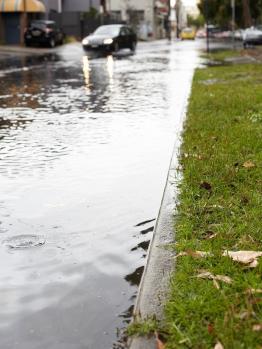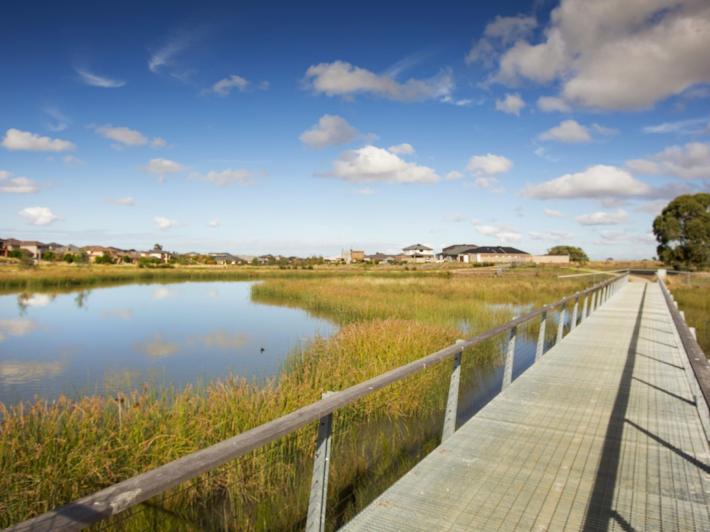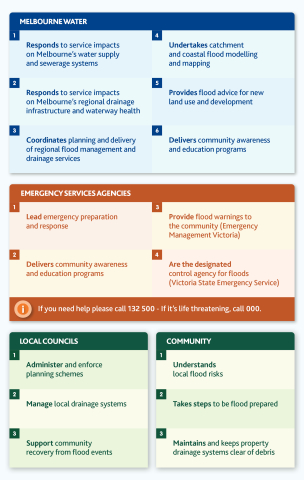Flooding is a natural part of the weather cycle, but it can have a big impact on our way of life in Melbourne. Our aim is to reduce the risks to individuals, property, and infrastructure. Learn about the reasons behind floods, our responsibilities, and our collaborative efforts in flood risk management.
Call Triple Zero (000) for life-threatening emergencies. For flood emergency help, call the Victoria State Emergency Service on 132 500
Floods and why they happen
Our stormwater system and infrastructure are designed to safely carry rainfall away from built-up areas into our rivers and creeks. This helps reduce the risk of flooding in our urban and suburban areas. However, our drainage systems were not designed to hold the increased water flowing through our landscape as a result of climate change and urban development.
As a result, we are facing increasing flood risk in parts of Melbourne. The flooding that we would typically only see on rare occasions is becoming more frequent and more severe.
As our cities become more densely populated, rainwater flows off hard surfaces faster, instead of filtering into the ground. This puts more pressure on our stormwater system and increases flooding along waterways and on low-lying land.
Climate change will continue to increase flood risk as the intensity of rainfall events increases, severe storms become more common, and the sea level rises.
Types of flooding
Flooding can be caused by many different rainfall events. When they occur, they can have a significant impact on our environment, wildlife, property and people living across Melbourne.
It’s important to know what kind of potential flooding may occur in the area you live, work and play. The more you know, the more prepared you will be.
Flooding can be caused by:
- rivers and creeks rising, and bursting their banks (waterway flooding)
- rainwater exceeding the capacity of drainage systems (stormwater flooding)
- ocean tides rising above normal levels (coastal flooding)
Prepare for flooding
Find out information about your flood risk and steps to help you minimise the impacts from flooding.
Flood management: our role and responsibilities
Melbourne Water manages all parts of the water cycle that are essential to our way of life today, tomorrow and for generations to come. This includes the health and safety of Melbourne’s water supply and sewerage systems, parts of our extensive drainage infrastructure and waterway health.
We also help to keep our homes and businesses safe from flooding by planning for the impacts of significant weather events.
We play a critical role in the management of flood risk, through:
Coordinating flood management
As the region’s floodplain manager, our role is to lead the development of the Port Phillip and Westernport Flood Management Strategy. This includes drainage services.
We work together with local and state government agencies, emergency services, insurance and private sector, and the community, to achieve this.
Read the flood management strategy
Understanding flood modelling and mapping
Melbourne Water reviews and develops new flood models to inform flood risk and build community resilience across the region.
They are also used by councils to inform planning and development decisions so that new growth happens in safer locations.
Melbourne Water has adopted the recommendations of the independent Maribyrnong River Flood Review, and will review the models every 5 years and update them every 10. Any major flood event experienced within this timeframe, will also trigger a review of our flood modelling.
Learn more about flood modelling
Maintaining the regional drainage network
We work with local councils to manage a complex drainage system that spans the entire city.
This involves planning to reduce the effects of stormwater on our well-known rivers, creeks, and bays.
Learn about our drainage system
Managing infrastructure
We deliver drainage and other infrastructure projects, like retarding basins to minimise the impact of flooding. This helps to safely carry stormwater away from built-up areas into rivers and creeks.
Learn more about retarding basins
Monitoring flood data
We monitor waterway levels and provide flood prediction data to the Bureau of Meteorology to help them issue flood warnings.
Access rainfall, river level and flow data
Supporting planning and development
We work with land developers to ensure the prevention of flooding and environmental damage in new developments.
This includes reviewing planning permits to check the planning process considers all flood risks.
Access property flood level information
Preparing communities for flood
Alongside our partners, we help to raise awareness of flood risk and ensure communities have the right information to prepare for floods.
Get prepared for a flood event
Managing flood risks together
Preparing for and managing floods is a shared responsibility. Together we have responsibilities for protecting people, infrastructure, assets, economic activity and the environment.
We partner with state and local government, business and the community to minimise the damage floods can cause to people, places and communities.
Victoria State Emergency Service (VICSES)
VICSES is the control agency for flooding in Victoria. They plan for flood events, support community preparation and manage flood response if a flood occurs.
Bureau of Meteorology
The Bureau of Meteorology (BOM) is responsible for issuing flood warnings.
Emergency Management Victoria
Emergency Management Victoria provides flood warning and alerts to the community via the emergency.vic.gov.au website and app.
Councils
Local councils manage the local drainage network, including street gutters and drains.
They are also responsible for:
- administering and enforcing planning schemes
- undertaking flood modelling and mapping of local drainage systems
- supporting local flood planning and coordinating local emergency planning
- supporting development of local community resilience.
Check your local council website for further information.
Residents and community
It’s everyone’s responsibility to be aware of their personal and local flood risk to prepare for floods. This includes residents and businesses.
How to manage your flood risks:
- understand your local flood risk
- maintain the gutters and drains on your property
- be prepared with an emergency plan to help reduce risks
- monitor flood warnings and advice.


